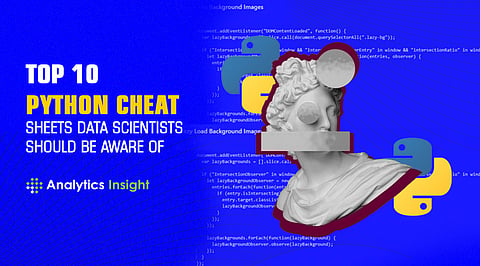

Data scientists are constantly using the trending and the most popular programming language known as Python in the data science field. There are innumerable elements to remember before starting a data science project. But it is overwhelming for data scientists to remember those within a short period of time. Thus, Python cheat sheet has come to the rescue to have a clear understanding of the programming language. Let's explore some of the top ten Python cheat sheets for data scientists to use in data science projects efficiently and effectively.
Python programming language consists of different variables and data types for data scientists to work with. There are variable assignments, calculations with variables, types, and type conversion to use in data science for a successful project. Calculations include subtraction, multiplication, exponentiation, remainder, and division of a variable whereas type includes variables to strings, integers, floats, and Booleans.
There are multiple Python libraries that help in different data science projects for data scientists. Pandas for data analysis, NumPy for scientific computing, Matplotlib for 2D plotting, and sckitlearn for machine learning. Two important concepts of this programming language are importing libraries and selective import.
The team of data scientists must know about IDEs or Integrated Development Environment through Anaconda, Spyder, and jupyter. Anaconda is known as the leading open data science platform powered by this programming language, Spyder is known as a free IDE, and jupyter is for creating and sharing documents with live code.
The Python cheat sheet for data scientists must include lists that are essential for multiple data science projects. There are three categories of lists such as selecting list elements, list operations, and list methods. Selecting list elements to include subset, slice, and subset lists of lists.
Strings are the essential elements to be on the Python cheat sheet including string operations, string indexing, and string methods. String methods consist of string to uppercase, a string to lowercase, counting string elements, replacing string elements, as well as strip whitespaces.
NumPy Arrays must be known to data scientists for selecting NumPy Array elements, Numpy Array operations, and NumPy Array functions. Different functions for data scientists include getting the dimensions and appending, inserting, deleting, mean, median, and correlation of items in an array.
Advancing indexing is a popular piece of information that must be on the Python cheat sheet for a clear understanding of the programming language in data science. It includes setting, resetting, reindexing, multi-indexing, and indexing. Reindexing includes forward filling and backward filling.
Data is an essential part of any programming language and data science. Thus, data scientists must have different types of data on this Python cheat sheet such as duplicate data, grouping data, missing data, combining data, dates, and data visualization. Grouping data consists of aggregation and transformation while combining data includes merge, join, and concatenate.
The Python cheat sheet must have the selection process including getting, selecting, Boolean indexing, and setting. This must consist of by-position for selecting a single value by row and column, by the label for selecting a single value by row and column labels, and by label/position for selecting a single row of a subset of rows, selecting a single column of a subset of columns, and selecting rows and columns.
Data scientists should evaluate the performance of a model through this Python cheat sheet. It includes classification metrics with accuracy score, classification report, and confusion matrix, regression metrics with mean absolute error, mean squared error, and R2 score, clustering metrics with adjusted rand index, homogeneity, and V-measure, as well as cross-validation.
Crypto Retreat has Taken a Big Toll on Crypto Exchanges in Q1: Report
Google's New Web3 Team will Capitalize on its Blockchain Dreams
Creating Avatar Boundaries is the Only Way to Give Value to Metaverse Lands
AzureML Will Put an End to Data Science Jobs in Near Future
You can Build a Successful Data Science Career with an Arts Degree
Join our WhatsApp Channel to get the latest news, exclusives and videos on WhatsApp
_____________
Disclaimer: Analytics Insight does not provide financial advice or guidance. Also note that the cryptocurrencies mentioned/listed on the website could potentially be scams, i.e. designed to induce you to invest financial resources that may be lost forever and not be recoverable once investments are made. You are responsible for conducting your own research (DYOR) before making any investments. Read more here.
